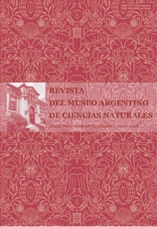New Patagonian Cretaceous theropod sheds light about the early radiation of Coelurosauria
Resumen
Here we describe a new theropod, Bicentenaria argentina nov. gen. et nov. sp., from the early Late Cretaceous of Patagonia. It is represented by more than a hundred bones belonging to different sized individuals, which were buried together in disarticulation after little transportation. The available association of skeletal elements suggests a gregarious behaviour for Bicentenaria
, an ethological trait also recorded among other theropod clades. Increasing documentation of monospecific assemblages of different groups of theropods suggests that a gregarious ehaviour may have constituted the ancestral condition for Theropoda, at least. Bicentenaria characterizes for the surangular bone with a high dorsal margin and a prominent lateral shelf, a retroarticular
process that is low, wide and spoon-shaped, and quadrate bone with its lateral condyle larger than the medial one. Phylogenetic analysis found the Chinese Tugulusaurus and the atagonian
Bicentenaria as successive sister taxa of all other coelurosaurs, thus revealing the importance of the new taxon in the understanding of the early diversification of Coelurosauria. In particular,
Bicentenaria amplifies the array of basal coelurosaurs that inhabited Gondwana during the Cretaceous, also including compsognathids, Aniksosaurus and Santanaraptor.
Although still restricted to a handful of forms, available information indicates that Gondwana was a cradle for the evolution of different lineages of basal coelurosaurs, different from those documented in Upper Cretaceous beds in the northern landmasses. Analysis of body size distribution in averostran theropods results in the identification of two main episodes of drastic size reduction in the evolutionary history of Coelurosauria: one occurred at the initial radiation of the group (as represented by Bicentenaria, Zuolong, Tugulusaurus, compsognathids, and Aniksosaurus), and a second episode occurred at the early diverification of Paraves or avialans. Reduction in body size may have allowed adult coelurosaurians to exploit ecological niches not occupied before by larger basal averostrans.
Texto completo:
PDFEnlaces refback
- No hay ningún enlace refback.

This work is licensed under a Creative Commons Attribution 3.0 License.

